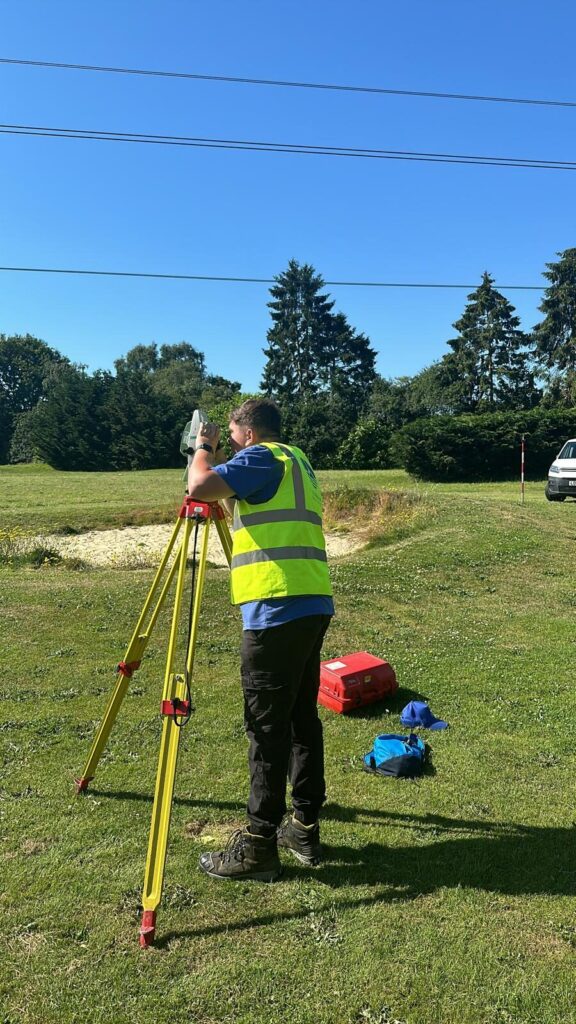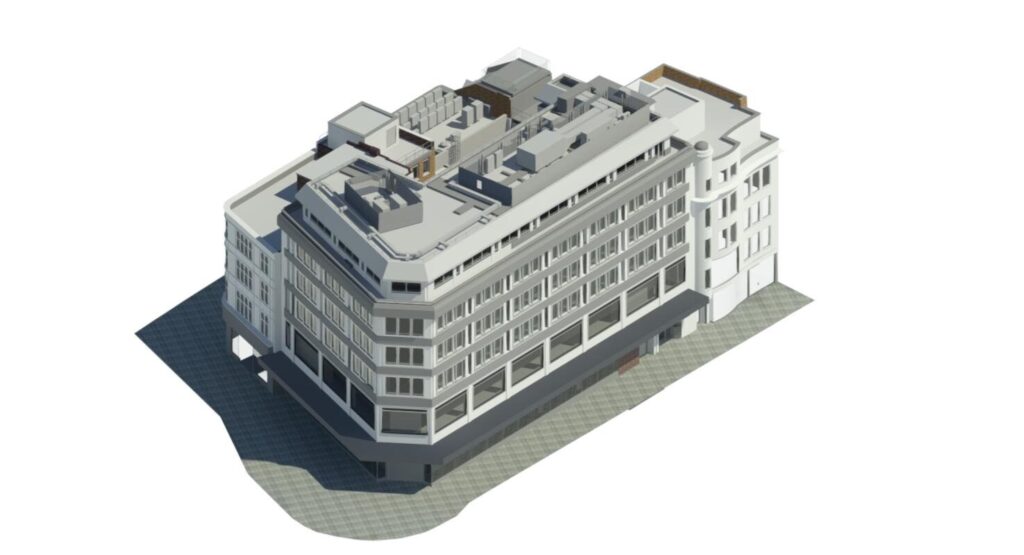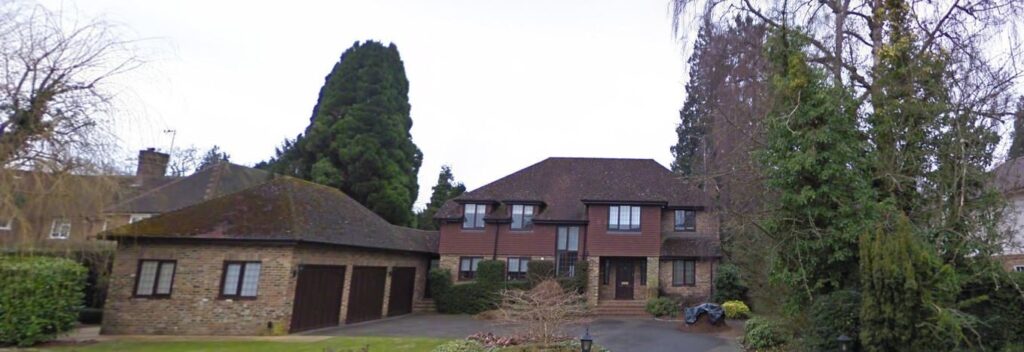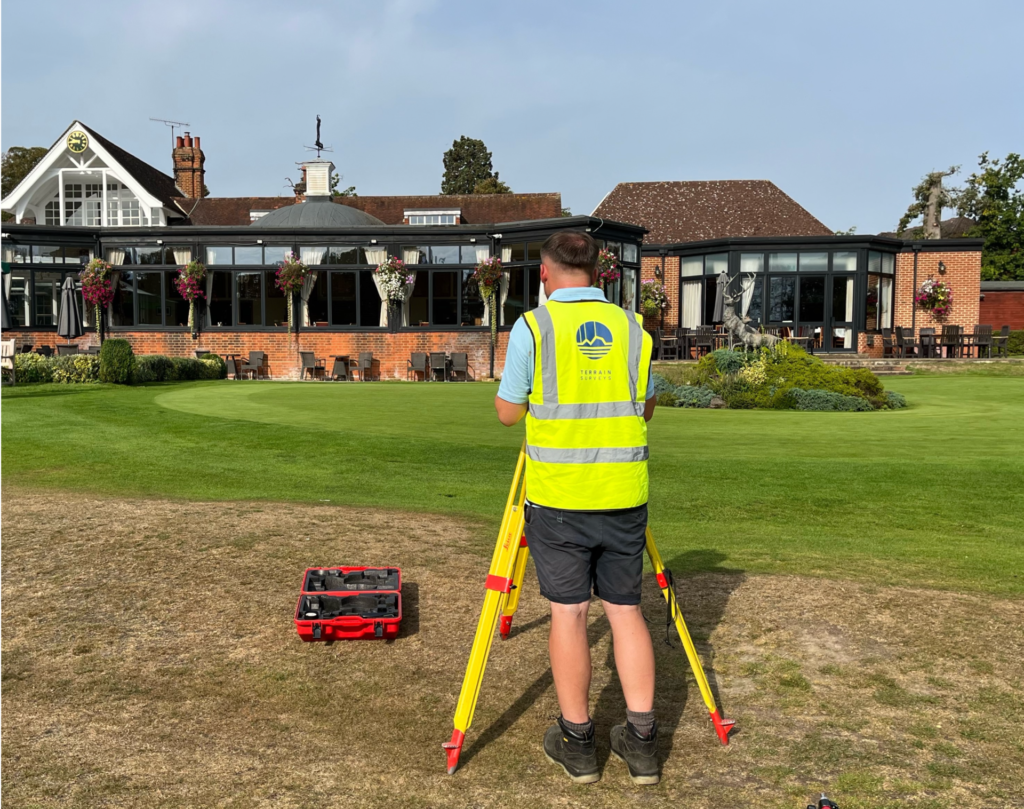Introduction
Topographical surveys (also known as topo surveys) are detailed plans that map out the natural and man-made features of a site along with their elevations. In other words, a topographical survey measures the position and height of everything from terrain shapes and slopes to structures and utilities on a piece of land.
These surveys matter because they provide a precise three-dimensional picture of a site’s conditions, which is crucial for architects, engineers, and planners. Without an accurate topo survey, projects risk costly surprises like unforeseen ground levels or hidden obstacles.
What Is a Topographic Survey?
A topographical survey is essentially a map-making exercise that records all visible features and elevation points on a site. Using specialised equipment, land surveyors capture both natural features (like ground contours, hills or depressions, streams, and trees) and artificial features (like buildings, roads, fences, and utilities).
The resulting survey plan shows these features as symbols or lines, often with annotations for ground heights (spot levels) and contour lines indicating elevation changes.
In practice, a topographical survey produces a detailed plan or digital model of the site’s surface, including boundary lines and vertical relief (height differences). This up-to-date plan becomes a foundation for any design or development work on the land. In fact, conducting a thorough topographical survey is a vital first step before embarking on detailed design for a project – it ensures planners and designers are working with accurate information about the site’s layout and levels.
Topographical surveys are sometimes simply called “land surveys” or “terrain surveys” because they give a full picture of the land’s shape (topography) and features.
Why Are Topographical Surveys Important?
Topographical surveys play an important role in virtually all land development and construction ventures. Firstly, they are often needed to satisfy planning and legal requirements – for example, local planning authorities may require a topographical survey as part of a planning application to verify site levels and features.
Having an accurate survey helps demonstrate that a proposed design will fit the site and comply with regulations.
Secondly, these surveys inform architects and engineers, giving these specialists a full picture of the land, including any off-site features or constraints that could impact the project.
This enables more robust and informed design decisions, such as positioning buildings to work with the terrain or planning drainage that follows the land’s natural slope. Crucially, a good topographic survey reduces risk: it helps avoid costly mistakes that might arise from unknown site conditions. For instance, if you failed to identify a sudden ground drop or an existing underground drain, you might face serious issues during construction. By having all features and levels mapped, surprises are minimised and construction can proceed more smoothly.
In short, topographical surveys are critical for planning, legal compliance, environmental assessment, and risk avoidance in construction. They ensure that projects start with solid ground truth data.
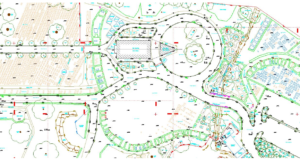
Beyond the design phase, topographic surveys are also important for environmental and feasibility studies. They help assess things like flood risk (by mapping low-lying areas and watercourses) and environmental impacts (by locating trees, streams, and other ecological features that need protection).
Developers use the survey data to plan earthworks – for example, calculating cut and fill volumes or identifying where retaining walls might be needed.
In summary, a topographical survey provides the ground truth that underpins successful site planning and development. It is a small upfront investment that can prevent big costly problems down the line, by ensuring everyone involved is literally on the same page regarding the site’s topography.
How Is Topography Measured?
Conducting a topographical survey is a multi-step process combining fieldwork and data processing to create an accurate map of the site. It typically begins with reconnaissance – surveyors visit the site to assess the terrain and plan the best approach. They will identify any challenges (for example, thick vegetation or difficult access areas) and decide what equipment and methods to use.
Next, the survey team establishes control points on site. These are fixed reference points (often marked by nails or stakes in the ground) with known coordinates and elevation, which serve as the backbone for measurements. For example, the surveyors might set up a GPS base station or a known benchmark and several temporary benchmarks around the site.
Once control is in place, the detailed data collection begins.
Surveyors systematically move across the site measuring points on all the features and the ground surface. They set up instruments like total stations (an electronic theodolite with distance meter) and roving GPS/GNSS receivers on the control stations and measure each detail one point at a time.
As they work, they record the coordinates (X, Y) and elevation (Z) of everything including; the ground level at various spots, the position of each tree, the top and bottom of kerbs, building footprints, utility covers, and so on.
Modern survey instruments often allow the surveyor to code features as they measure – for instance, tagging a point as “building corner” or “road centerline” – which helps later in drawing the map.
Throughout the survey, the crew will periodically check back to the control points to ensure their measurements stay accurate and adjust equipment if needed.
After the field measurements are complete, the focus shifts to data processing in the office. The collected raw data (coordinates and measurements) are uploaded into specialised software (such as CAD). Here, surveyors process and adjust the data for accuracy – performing checks, merging data from multiple instruments, and filtering any errors.
They then generate the topographical map or digital model. This involves plotting all the points and connecting them with lines or symbols according to what they represent. For example, points measured along a roadway kerb will be joined to form a continuous line of the kerb, tree trunk locations might be shown as tree symbols of correct diameter, and spot heights will be annotated.
Contour lines are interpolated (or calculated) to depict the terrain relief at regular intervals (e.g. every 0.5m or 1m height change), giving the familiar visual of elevation lines curving across the plan.
The end result is a detailed topographical survey drawing, usually delivered as a digital file (like an AutoCAD DWG) along with PDF hard copies if needed.
This drawing includes all the required features and labels – often with a legend explaining the symbols and a coordinate grid or reference to an Ordnance Survey datum if tied into national mapping.
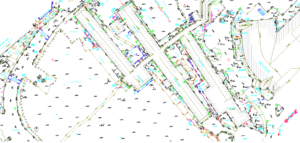
Before final delivery, the surveyors perform rigorous quality control checks on the drawing to ensure everything aligns correctly and that no features were missed or inaccurately depicted.
The team at Terrain Surveys, leverages modern technologies to improve efficiency and accuracy in these types of surveys. For example, we use high-precision GPS units to quickly establish control and gather broad data, and total stations for detailed point-by-point measurement. In suitable sites, we may deploy 3D laser scanners or drones to capture large amounts of data (more on those methods below).
By combining these tools, today’s topographical surveying is both faster and more precise than the traditional methods, allowing us to produce very detailed 3D maps that reflect the vast areas of terrain with centimetre-level accuracy.
Ultimately, measuring topography is a blend of time-tested techniques (“boots on the ground” measurements) and cutting-edge technology, all aimed at creating a trustworthy model of the site that clients can design and build upon confidently.
What Measurements Are Included?
A topographical survey captures a wide range of information about a site. The exact measurements included will depend on the project needs, but generally the survey will record all visible physical features and the ground elevations across the area. Here are some of the key measurements and features typically included:
- Ground elevations and contours: The survey provides spot height measurements at various points on the ground and along features. From these, contour lines are drawn to show lines of equal elevation, illustrating the shape of the land (hills, valleys, slopes). For instance, you might see a contour line for every 0.5 m change in height. Critical elevation points like high and low spots are noted, and features like retaining walls or embankments will have top/bottom levels recorded.
- Boundaries and fences: The positions of boundary lines are measured, including fence lines, hedges, and walls marking the edges of the site. While a topographical survey is not a legal boundary survey, it will show the physical boundary features present. This is important for understanding the extent of the property and any encroachments.
- Buildings and structures: All existing buildings on the site (and often adjacent buildings near the site boundaries) are measured. The survey will usually show building footprints (outlines) along with critical levels such as threshold levels (entrance floor elevations), eaves and ridge heights of roofs, etc.
Small structures like garages, sheds, retaining walls, and even things like lamp posts or signage are picked up too. - Roads, paths and hard surfaces: Any roads or driveways are included, with detail such as the edge of pavement, centreline, and kerb positions. Footpaths, patios, and other hardstanding areas are surveyed, often noting the surface material (tarmac, concrete, gravel etc.). Changes in surface (e.g. where a tarmac driveway meets a grass lawn) are indicated as well.
- Utility features: Topographical surveys usually locate utility apparatus visible on the ground surface. This includes things like manhole covers, inspection chambers, storm water gullies, utility valves, telecommunication boxes, and utility poles or overhead lines. For each cover or chamber, the cover level is taken (and in some cases inverts – the depth to the pipe – if accessible). Knowing where drainage and utility points are can be crucial for design and construction planning.
- Vegetation: Significant vegetation is recorded. Single trees are positioned (typically with trunk location and maybe canopy spread) and often labelled by species or an ID number if a tree survey is combined. Groups of trees or woodland edges are outlined. Hedges and shrubs are shown as areas or lines. Tree canopies may be depicted with a dashed outline indicating their extents. Height information like tree canopy height can also be included for larger trees.
- Miscellaneous features: Surveys will pick up all sorts of other features present on the site – for example, streams or ponds and their extents, culverts, garden features, posts, benches, and any “street furniture” (bins, streetlights, signs) on or near the site. Essentially, anything visible that could impact design or construction is measured. Even things like overhead cables across the site are noted with their clearance height.
- Coordinate grid and datum: Importantly, the survey will note the coordinate system and datum used. Many topographic surveys in the UK are tied to the Ordnance Survey National Grid for horizontal coordinates and to Ordnance Datum (Newlyn) for vertical heights (sea level) if required. This means the survey can be overlaid on OS maps and everyone has a common reference for levels (e.g. “all heights are above mean sea level”). If not tied to OS, a local grid and temporary benchmark will be used and described in the survey notes. Terrain Surveys often supplies data in both the local site grid and OS coordinates as needed.
All these measurements come together to form a comprehensive topographical plan.
The final drawing is typically heavily annotated – different symbols and line types indicate different features, and a legend is provided to explain them. For example, there may be distinct symbols for trees, spot elevation numbers for levels, and color-coded lines for different services.
Every point surveyed is spatially accurate to the project’s required tolerance.
The level of detail can be tailored to the client’s needs (for instance, a simple survey might omit very small features, whereas a detailed survey will show even individual garden shrubs).
By including all this information, a topographical survey ensures that designers have all the key site measurements at their fingertips, avoiding assumptions. It essentially creates a snapshot of the site in its current state, accurate in both horizontal and vertical dimensions.
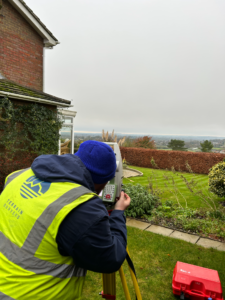
Surveying Methods
There are several methods and tools that may be used to carry out a topographical survey. Each surveying method has its advantages, and often a combination is used to achieve the best result. The choice of method depends on factors like the size of the site, the type of terrain, accessibility, required accuracy, and the project timeline.
In this section, we’ll explore the main surveying methods – Total Station, GPS/GNSS, Drone (UAV) surveying, and Laser Scanning – and how they contribute to topographical surveys.
Total Station Surveying
A total station is a classic surveying instrument that combines a theodolite (for measuring horizontal and vertical angles) with an electronic distance meter (EDM). In practice, a total station allows a surveyor to precisely pinpoint feature locations by measuring angles and distances from the instrument to a prism or a target held on that feature.
Total stations are typically mounted on a tripod over a known point. The surveyor aims the instrument at a prism staff held on the feature point; the total station then calculates the distance and angle, which is used to compute the coordinate of the point. This method yields very high accuracy and is excellent for detailed work – for example, mapping building corners, kerb lines, or any feature that can be directly observed from the instrument’s line of sight.
Terrain Surveys’ teams often use robotic total stations, which can be operated by one person. These instruments have on-board data collectors with feature code lists, so the surveyor can instantly code each point (e.g., as a fence, road edge, etc.).
Total station surveying is well-suited for sites of all sizes, especially where high detail is required. However, on very large sites, it can be time-consuming to traverse every area with the total station; that’s where integrating other methods can help.
Typically, a total station is used in combination with GNSS or other methods – for example, to fill in details under tree cover where GPS might not work, or to get precise elevations along a building face. Total stations remain a backbone of topographic surveys due to their precision (often millimetric) and reliability.
GPS/GNSS Surveying
GPS/GNSS surveying uses signals from satellites to determine positions on the ground. GNSS (Global Navigation Satellite System) is the general term, which includes GPS (the American system) and others like GLONASS, Galileo, and BeiDou. Using a GPS/GNSS receiver, a surveyor can quickly acquire the coordinates of a point by connecting to satellites – often achieving accuracy of a couple of centimetres when using professional equipment and techniques like RTK (Real-Time Kinematic) corrections.
In topographic surveys, GPS is commonly used to establish survey control and to measure large open areas efficiently. For instance, the survey team might use a fixed base station receiver and a roving receiver to capture points across the site.
One key advantage of GNSS is speed and range: a rover can move across a big field and log points rapidly without needing line-of-sight to a base station (unlike a total station which needs line-of-sight to the prism). This makes it ideal for surveying large, relatively clear sites like fields or along road networks.
Terrain Surveys uses GPS to pick up ground levels and general features over wide areas, and to tie the survey into the Ordnance Survey national grid if required.
Modern network RTK systems even allow surveyors to connect to a nationwide correction service via mobile internet, removing the need for a local base station in some cases.
However, GPS has limitations: it requires a clear view of the sky. Under dense tree canopies, in narrow urban streets (“urban canyons”), or inside structures, GPS signals might be blocked or bounce (causing multipath errors). In those cases, total stations or other methods take over. Despite these caveats, GNSS is a highly efficient surveying method, and when combined with total stations, it gives the best of both worlds – broad coverage and fine detail. In short, GPS surveying adds speed and global reference to topographic surveys, ensuring points can be related to real-world coordinates easily.
Drone (UAV) Surveying
Drone surveying has emerged as an innovative method to capture topographical data from the air.
Unmanned Aerial Vehicles (UAVs) equipped with cameras (for photogrammetry) or LiDAR sensors can overfly a site to gather a large amount of data quickly. This method is especially useful for large or hard-to-access areas – for example, surveying a quarry, a steep hillside, or a vast open field. Using a drone, Terrain Surveys can conduct airborne surveys that cover large areas efficiently.
There are two main techniques here: aerial photogrammetry and aerial LiDAR.
In photogrammetry, the drone’s camera takes many overlapping high-resolution photos of the ground. These images are later processed with software that stitches them together and extracts 3D information by identifying common points in multiple images (much like how our eyes perceive depth). The result is a dense 3D point cloud or mesh of the terrain and an orthophoto (a scaled aerial image) of the site. Aerial LiDAR, on the other hand, uses a laser scanner on the drone to directly measure distances to the ground, producing a 3D point cloud of the surface (which can even penetrate gaps in vegetation to map the ground under trees).
The advantages of drone surveying are speed and coverage. A drone can survey in hours what might take days on foot. It also minimises the need for surveyors to physically traverse dangerous or inaccessible terrain (imagine a cliff or a busy highway).
The data gathered is very rich – often millions of points – allowing for detailed terrain models. The three-dimensional information from aerial surveys can be as detailed as traditional methods for many purposes.
Drone surveys usually require some ground control points surveyed by GPS/total station to ensure the data is properly scaled and located, and there are regulatory considerations (licensed pilots, airspace permissions, weather constraints).
In practice, we normally will integrate drone data with ground surveying: for instance, using the drone to capture the overall terrain and then using ground crews to survey obscured details or critical hard features that require higher accuracy.
When used appropriately, drone surveying is a powerful addition to topographic surveys, providing a “big picture” view and a detailed terrain model that can be sliced into contours, profiles, and so on. It exemplifies how modern technology is pushing the depth of what topographic surveys can deliver.
Laser Scanning (TLS and Mobile Scanning)
Laser scanning technology has revolutionised how surveyors capture detailed 3D information. In the context of topographical surveys, laser scanning typically refers to Terrestrial Laser Scanning (TLS) – a scanner on a tripod – or mobile LiDAR scanners that can be vehicle-mounted or handheld.
A laser scanner shoots out thousands of laser pulses per second in a 360° sweep, measuring distances to every surface it hits. The result is a dense “point cloud” of 3D points covering structures and terrain. Laser scanners can capture millions of points in a matter of minutes, which is incredibly useful for complex sites with lots of detail. For example, in an urban topographic survey, a TLS can quickly scan building facades, intricate structures, or areas where access on foot is limited (like a busy intersection) and gather all visible geometry. Mobile scanning (mounted on a vehicle or backpack) can collect data along roads or extensive areas as the surveyor moves through the area, though with slightly less accuracy than static TLS.
The key benefit of laser scanning is detail and completeness. Instead of picking individual points one by one, you effectively capture everything in view. This is excellent for creating 3D models or when you need to ensure no detail is missed (like for heritage sites or very complicated industrial areas).
The point cloud output can be processed to extract traditional survey elements: for instance, you can slice it to derive contours or digitize features like edges and breaklines from it. Laser scanning is extremely precise.
Terrain Surveys employs laser scanning in many projects – often under their 3D laser scanning services – to supplement topographical data. For example, scanning might be used to get floor level data inside a building or to capture a highway overpass geometry as part of a land survey.
TLS does require line of sight (it can’t see behind objects unless you move the scanner to multiple setups) and generates large data files.
Not every topographical survey will need a full laser scan, but for high-detail surveys or where accurate 3D visualization is needed, it is ideal. In combination with mobile mapping or drones, laser scanning ensures even complex topography is measured.
Overall, laser scanning adds a new depth to topo surveys by capturing comprehensive 3D point data, which can be invaluable for design and BIM (Building Information Modelling) integration. It is an example of advanced technology that good surveyors use to deliver cutting-edge results for clients who need that extra level of detail.
Choosing the Right Survey Method
With multiple surveying techniques available – from traditional levels to flying drones – a common question is which method is best for a given project. The truth is, the “right” survey method depends on the specific needs and constraints of the site and project. Terrain Surveys approaches each topographic survey by tailoring the methodology to achieve the required accuracy, detail, and efficiency for that particular job.
Several factors influence the choice of method:
- Size and terrain of the site: A small, congested urban site might be best handled with total stations and laser scanners for maximum detail, whereas a large rural site could benefit from GNSS for broad coverage and perhaps a drone flight to quickly capture the overall terrain. If a site has mixed conditions, multiple methods will be combined – for example, using GPS in open areas and total stations under tree cover or between buildings where satellite signals are poor.
- Required level of detail: If the project demands very fine detail (say, documenting the precise shape of building facades or irregular structures), laser scanning would be appropriate to capture that complexity. Conversely, if the survey is for a preliminary feasibility with moderate detail, a faster method like photogrammetry might suffice for the bulk of the work, with a few targeted ground shots for critical points.
- Accessibility and safety: If parts of the site are unsafe or hard to reach (steep slopes, marshland, busy roadways), remote methods like drones or long-range laser scanners allow data collection without putting personnel at risk. For example, a drone can map a cliff face that would be dangerous to climb, or a scanner on the opposite building can capture details of a site across a busy street without stepping into traffic.
- Timeline and budget: Sometimes speed is the priority – e.g., a tight project deadline might favour deploying multiple teams with GPS and total stations to finish the fieldwork quickly, or using a drone to shave days off field time. Budget considerations also matter; while advanced methods provide more data faster, they can be costlier in both fieldwork and data processing in the office. Terrain Surveys will work with the client to balance these factors, perhaps opting for the most efficient technology that meets the spec.
Often, the answer is a hybrid approach. Modern surveying is not either/or – it’s about using the best tool for each aspect.
Terrain Surveys’ expertise across all these methods is a big advantage. Because we are proficient in traditional and modern techniques alike, we can objectively choose the right combination rather than being limited to one approach.
Clients therefore get a survey that is optimised for accuracy and cost-effectiveness. Whether it’s a simple one-day GPS survey or a complex multi-method project with scanning and UAVs, the goal remains the same: deliver a reliable topographic survey that meets the project’s needs.
Sustainability in Surveying
Sustainability might not be the first thing people associate with land surveying, but it is becoming an increasingly important consideration. Surveying for construction and development is part of shaping the built environment, so it’s crucial that it’s done in an environmentally responsible way. Terrain Surveys recognises this responsibility and has made sustainable practices a key part of its operations
One aspect of sustainability in surveying is minimising environmental impact during fieldwork. This can include simple measures like planning efficient routes through the site to avoid unnecessary trampling of vegetation, or scheduling drone flights at times that won’t disturb local wildlife. Using drones or remote sensing can actually reduce ground disturbance compared to sending a crew everywhere on foot or with vehicles. Terrain Surveys also adheres to any environmental restrictions on sites – for example, avoiding work in ecologically sensitive areas during nesting season, or using biodegradable survey markers when working in natural landscapes.
When to Commission a Survey
If you’re wondering at what stage you should get a topographical survey done for your project, the answer is usually “as early as possible.” Topographical surveys are a fundamental starting point for many endeavours, and there are several ideal scenarios where you should commission one:
- Pre-construction planning: Before architects start designing and engineers start calculating, a topo survey should be in hand. Whether you’re planning a single house extension or a large housing development, knowing the exact ground levels, positions of trees, nearby buildings, etc., is critical. For example, designing a new house or extension will require understanding how the land slopes and the heights of surrounding features. On larger developments, a survey is one of the key starting points before layout designs for roads, drainage, or plot divisions are done.
- Planning permission and approvals: Many planning authorities require a detailed site survey to be submitted with development plans. A topographic survey can satisfy these requirements by demonstrating existing site conditions (and sometimes proposed changes in context). If you need to show that an access road meets a highway at a safe gradient or that your new building won’t block a neighbour’s light due to terrain differences, the topo survey provides that evidence.
- Designing infrastructure and landscaping: Anytime you’re designing infrastructure like roads, driveways, drainage systems, or significant landscaping, a survey is needed. For instance, to design new road alignments or tie-ins to existing roads, you’ll need accurate levels and positions. Similarly, for drainage design, understanding the fall of the land is crucial to ensure water will flow correctly and to locate existing drainage features. Earthworks calculations (cut and fill) for regrading a site also rely on topo data.
- Legal and boundary matters: While a topographical survey is not the same as a legal boundary survey, it often becomes important in legal contexts. If there’s a boundary dispute or uncertainty, a topographic survey can mark existing boundary features which can then be related to title plans. When registering land or easements with HM Land Registry, having a detailed survey can be very helpful – indeed, topographic survey data is often used to create Land Registry compliant plans for transfers. In short, if land ownership extents or rights of way need clarification on the ground, a survey is advisable.
- Environmental and feasibility studies: Commission a survey if you’re evaluating a site’s potential or constraints. For example, flood risk assessments require accurate terrain models to simulate water flow – a survey will provide the needed contour data. Ecological or tree surveys often overlay their findings on a topographic plan, so doing the topo survey first is logical. If you plan to do a geotechnical investigation (boreholes, trial pits), a topo survey helps plan those locations and log their coordinates and elevations.
- Before major changes or purchases: If you’re buying a piece of land for development, getting a topographic survey early will inform you of any hidden issues (like unexpected steep gradients or drainage problems) that could affect your plans. Likewise, if you intend to sell a property with development potential, a professional survey can add value by providing certainty to buyers.
- During and after construction: Sometimes surveys are commissioned during construction (for setting out purposes, though that’s more of a construction stakeout than a topo) and certainly after construction for “as-built” records. An as-built topographic survey at the end of a project will document how the site was actually built – useful for client records, facilities management, and closing out permits. It may include checking that finished grades match design grades, or creating final mapping for record drawings.
In summary, you should commission a topographical survey whenever you need an accurate understanding of the site’s existing conditions to inform decisions. Early is best – having a thorough survey at an early stage helps mitigate risk, reduce the chance of costly mistakes and it removes guesswork.
Terrain Surveys often advises clients to get the survey done before even the schematic design phase, because so many critical decisions (building placement, cut/fill requirements, drainage strategy, etc.) depend on topography.
By timing the survey right, you ensure that all stakeholders – designers
Why Choose Terrain Surveys?
With over two decades of experience and thousands of successful projects across the UK, Terrain Surveys is your trusted partner for topographic surveys. Our expert team combines deep technical knowledge with a forward-thinking approach, using the latest technology—from drones and laser scanners to advanced CAD and BIM software—to deliver surveys that are accurate, reliable, and ready to support every stage of your project.
Terrain Surveys operates nationwide, with regional teams positioned for quick mobilisation and local insight, whether you’re developing in central London or the Scottish Highlands. Our comprehensive services go beyond topographic surveys to include measured building surveys, 3D models, utility mapping, drainage surveys, and more—making us a true one-stop solution.
Clients choose Terrain Surveys not just for precision and professionalism, but for our outstanding customer service. Every survey benefits from hands-on involvement by senior engineers, and is tailored to meet the unique needs of each project. From initial enquiry to final deliverables, you’ll benefit from responsive support, clear communication, and expert advice that helps you get the most from your data.
Whether you’re planning a small development or a large infrastructure project, Terrain Surveys brings the capability, technology, and care to ensure your survey is done right, first time.
Contact Terrain Surveys today to discuss your needs or to request a consultation and quote. With their expertise on your side, you can proceed with confidence, knowing you have the best possible understanding of your site. Let Terrain Surveys unlock the potential of your project by providing the detailed terrain insight you need to build with certainty. Feel free to reach out by clicking here.
